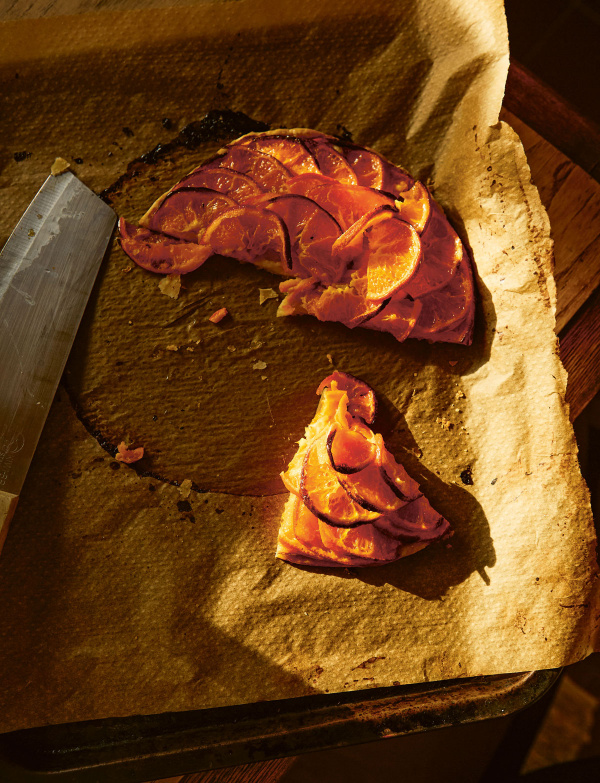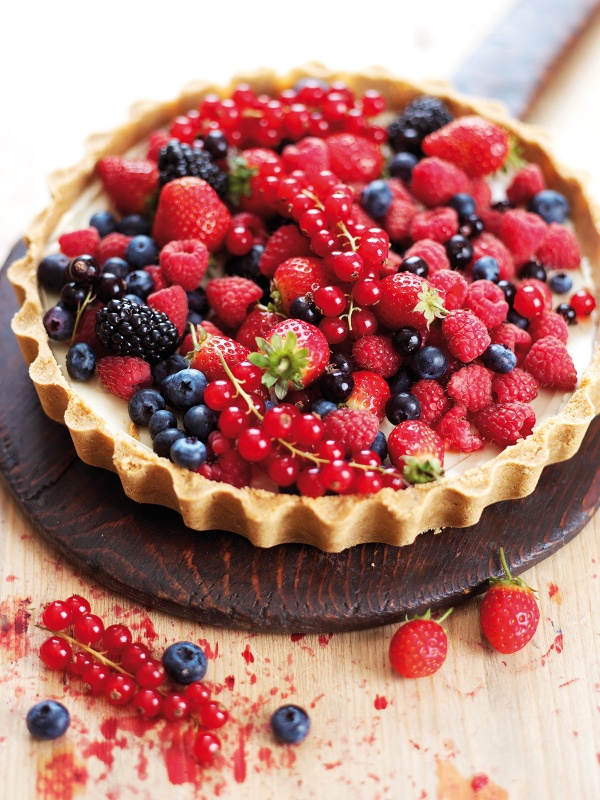Tangerine Tart
by Stephen Harris, featured in The Sportsman At Home Published by QuadrilleIntroduction
This tart is almost healthy as it has no added sugar. The idea is based on a tarte fine aux pommes, but using tangerines instead of apples. It’s important to follow the instructions carefully, and make sure you have the right knife to slice the tangerines. I use a ceramic knife, but some people may prefer a serrated knife. It seems that you can judge a tree or plant’s success by how widespread it has become. If this is the case, then the citrus genus would seem to be a winner. Not only has it conquered the subtropics and mild, temperate zones of the world but we even grew a lemon tree in the conservatory of The Sportsman. At the time of writing, it has been a particularly grey, low-skied start to the year – so much so, that I did something was struck by the bright green colour, the fragrance and the beauty of the segments as well as the vesicles containing small amounts of juice. It made me realise what a magnificent thing it is that just when we are struggling with short, dark days, we have citrus fruits to cheer us up.
Citrus appears to have originated from an area stretching from north-east India to China and then spread to South-east Asia before arriving in Europe. It is very tricky to be precise, as it is so easy to cross-pollinate different varieties, but it appears that all citrus fruit can be traced back to just a few. These are the citron, mandarin and pomelo, with all the other varieties being variants and crosses of these. For example, the relatively recent hybrid grapefruit is a combination of sweet orange and pomelo. There is something satisfying about the easily identifiable roots of each fruit, their names often demonstrating how they spread around the world – mandarin from China, satsuma from Japan and tangerine from Tangier. I would have thought that Europeans in the Middle Ages would have taken to citrus fruit as a rather magical import, but history tells us that raw fruit was originally seen as more medicinal than anything else. It must have made an impression by the 16th century, however, as I remember being captivated by a painting of a marketplace in Antwerp that was packed with baskets of limes, lemons and oranges.
The skin of citrus fruit is part of its success in conquering the world. Not only does it provide the perfect packaging, which allows for easy transportation, but it also contains the essential oils of the fruit. We all know how grating the skin of a citrus fruit releases the flavour and aroma from its oils – something that is relevant to this recipe. The tart is based on one that was created by a great French patissier called Alex Croquet, who has a shop in Lille. I tried it at an event organised by Mikael Jonsson of Hedone restaurant in Chiswick and was captured by its simplicity. It is based on a classic tarte fine aux pommes, which uses apples, but instead uses a small, sweet variety of orange. The only thing that worried me was serving the pith of the oranges, as it can be so bitter, but it is balanced by the sweetness. I was interested to read that the bitter taste in the peel of citrus fruits is soluble in water but the oils aren’t, which means that, in theory, you could soak the peel in water to get rid of the bitterness. Another solution would be to spread some marmalade under the fruit just as some patisseries layer apple purée under the apples in their tarte fine aux pommes. I rather like the austere version, as it seems to reflect the time of year when we are getting over the excesses of Christmas.

Share or save this
Ingredients
Serves: 6-8
- 1 all-butter ready-rolled puff pastry sheet (you will have some left over, so cut the circle from the corner)
- vegetable oil (for brushing)
- 6 - 8 clementines or mandarins (choose whichever is available or the best, and try to get seedless if you can)
- creme fraiche or vanilla ice cream, to serve
Method
Tangerine Tart is a guest recipe by Stephen Harris so we are not able to answer questions regarding this recipe
- Preheat the oven to 180°C fan (400°F).
- Spread out the puff pastry sheet on a work surface. Cut out a 23 cm (9 inch) circle using a very sharp knife (I know pastry chefs who use a Stanley knife as it gives such a clean cut, which means the edge will ‘puff ’ up better).
- Brush a baking sheet with a very light coating of oil, then place a sheet of baking parchment on top – it will adhere, thanks to the oil.
- Place the circle of puff pastry on the baking sheet and prick it all over with a fork.
- With a very sharp knife, slice off the tops of the tangerines (or your chosen fruit), then continue to slice into very thin slices. The slices must be very thin so that there is not too much pith in each one. It doesn’t matter if the slices are not perfect because you can cover them up when you put them on, just make sure there is not too much pith!
- When you think you have enough slices, start to assemble the tart. Start in the middle and fan the slices in an ever-increasing circle. Make the sure the fruit overlaps so that less than half of the previous circle is visible – this is very important as the fruit slices will shrink when cooked and your tart will not look ‘full’. This also applies to the edges, so keep the slices going until they are very close to the edge. It will look like a large mound of fruit but this is needed to compensate for shrinkage.
- Cook in the oven for 30–40 minutes until the pastry is well cooked and deep brown in colour. This ensures that the tart bottom is crisp.
- When the tart is done, remove it from the oven and transfer it to a wire rack using a large slice. Allow to cool slightly.
- Serve with crème fraîche or good vanilla ice cream.







Tell us what you think
Thank you {% member.data['first-name'] %}.
Explore more recipesYour comment has been submitted.